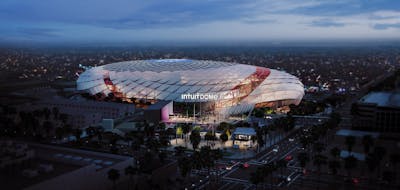
Truist Park (formerly SunTrust Park)
Shaping a new era in engineering and design modeling
Project Facts
| Location | Atlanta, Georgia |
| Owner | Cobb-Marietta Coliseum and Exhibit Hall Authority |
| Size | 1,200,000 SF |
| Cost | $475 million |
| Status | Completed 2017 |
| Certifications | LEED Silver |
Overview
The Atlanta Braves’ new stadium stands as a remarkable centerpiece at the heart of The Battery Atlanta, a sprawling 60-acre mixed-use development featuring apartments, offices, and restaurants. Walter P Moore’s team engineered an innovative modeling approach that ensured seamless alignment between the stadium’s seats and its steel structure, setting new standards for precision and functionality.
Services
About the Project
This development, the Atlanta Braves’ new home, truly stands in the spotlight within The Battery Atlanta mixed-use development complex. The three-tier grandstand stretches from the right field foul pole around home plate to the left field foul pole encompassing the majority of the field. This includes 4,000 premium seats distributed among several club spaces. The top deck is split, allowing fans to view the field when on the concourse.
The stadium features the largest canopy in Major League Baseball. The large sunscreen above the upper deck enhances spectator comfort by providing significant shading during a hot summer game day. Using state-of-the-art parametric modeling techniques, Walter P Moore created an optimization routine that simultaneously evaluated hundreds of shapes and sizes for the canopy and then correlated the resulting structural quantities and costs to the amount of shaded seating in the bowl in real time. This highly sophisticated analysis helped guide the final form of the architecture.
In addition, our team created a mathematical model to define the entire precast seating bowl and supporting steel structure by identifying the parameters that determine the relationship between the two systems. This level of precision and detailed coordination, which typically occurs during the construction phase, instead happened during the early design phase, and was updated in real-time in our design and documentation models as the design progressed. This allowed the design team to not only adapt quickly to changes in bowl geometry but also to ensure precise locations of the structural steel at every location so the model could be used reliably by downstream parties.







